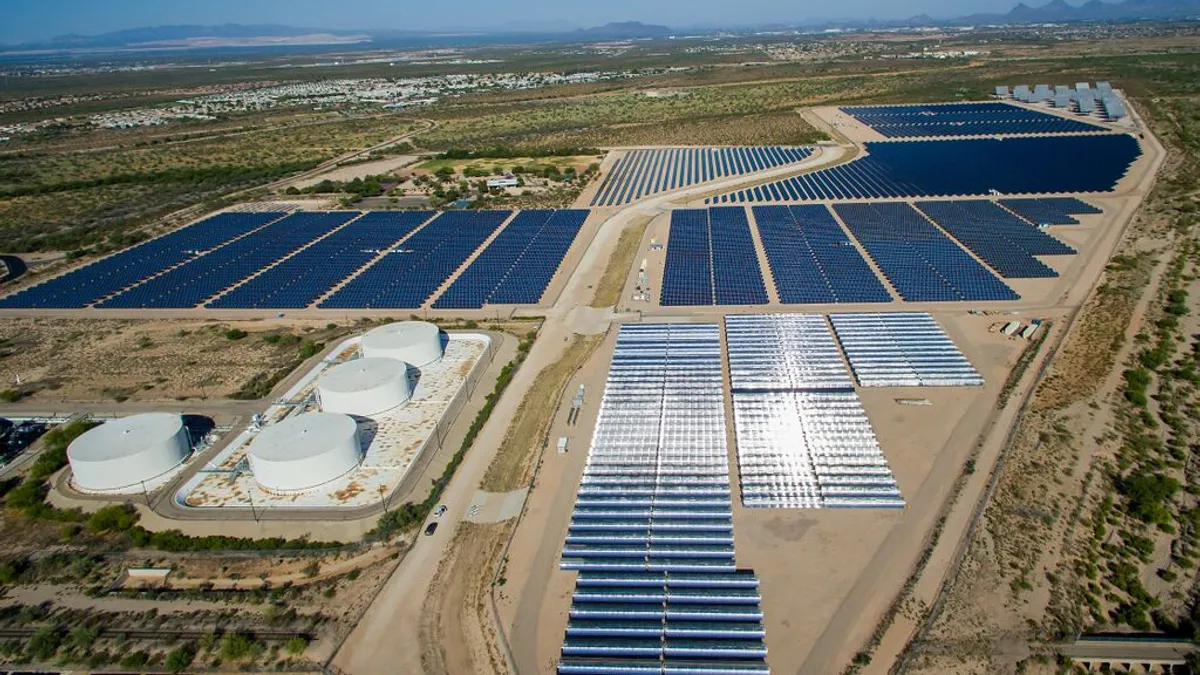Dive Brief:
- Tucson Electric Power's latest Integrated Resource Plan (IRP), released Friday, calls for a "dramatic" shift toward renewable resources.
- Solar, wind and energy storage systems will account for 70% of TEP's generation capacity by 2035, according to the utility. The IRP also calls for the retirement of TEP's remaining coal-fired power plants within 12 years.
- The new plan, which officials say was inspired by consumer demand and economic considerations, leaves Arizona with just two coal power plants without known closure dates.
Dive Insight:
TEP's latest IRP has moved Arizona one step closer to coal-free electric generation, local environmentalists say.
The plan would install 2,457 MW of new wind and solar generation, including 457 MW that will be operational by the end of this year. The IRP also calls for installing 1,400 MW of energy storage, and establishes a timetable for closing two coal-fired generation units at the Springerville Generating Station by 2032 — a plan the TEP believes will allow it to reduce the plant's workforce by attrition rather than mass layoffs.
TEP's plan is expected to reduce its carbon emissions 80% below 2005 levels by 2035, and will reduce water usages by 70%, according to the utility.
Growing utility use of solar-plus-storage suggests the plan "is definitely something TEP can do, and it will benefit rate payers, the air, the water, and of course the climate," said Sandy Bahr, director of the Grand Canyon Chapter of the Sierra Club.
The plan will also leave Arizona with just two operating coal plants after 2040. According to a 2019 report by Strategen Consulting, commissioned by the Sierra Club, the remaining two units at Springerville Generating Station, owned by Tri-State Generation & Transmission and the Salt River Project, still have no announced closure date. There is also no planned closure date for the Salt River Project's Coronado Generating Station.
The TEP units at Springerville were originally slated for closure in the 2040s, according to the Strategen report.
Bahr noted the shift follows the Arizona Corporation Commission's 2018 decision to reject TEP's previous IRP, citing over-reliance on natural gas generation.
"So I think this does mark a change of direction. And the fact that their IRP wasn't acknowledged ... perhaps that sends a message: Don't just come back with the same old thing" Bahr said.
The goals outlined in this latest IRP were primarily driven by TEP customers' desire to reduce carbon emissions in line with global efforts to address climate change, according to Joseph Barrios, a TEP spokesperson.
"We know our customers count on us to make smart energy decisions, providing more sustainable service that remains reliable and affordable," Barrios said in an email. "The costs of investment in solar and wind resources continues to decrease while energy storage technologies are projected to become more reliable and cost effective over time."
In addition to considering the environmental impact and affordability into account, Barrios said TEP was concerned that "the planned closure of other coal-fired power plants could lead to coal mine closures that limit long-term fuel availability."













